Plankton and Their Role in Aquatic Ecosystems
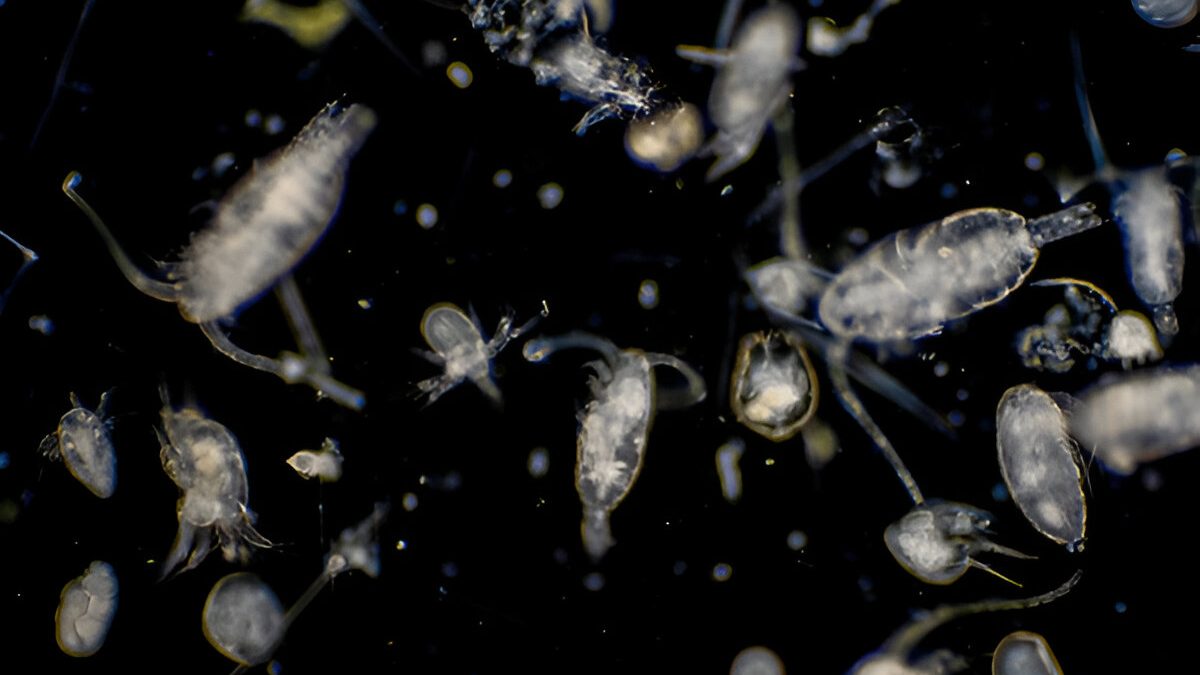
Photo Credit : Choksawaditdikorn
Plankton are tiny organisms that drift with the currents in water bodies, ranging from freshwater lakes and brackish estuaries to the vast oceans. Despite their microscopic size, plankton play a crucial role in maintaining the health and balance of aquatic ecosystems. These organisms form the foundation of the aquatic food web, providing nourishment for larger creatures, contributing to oxygen production, and aiding in the breakdown of organic matter. In this article, we'll explore the vital role plankton play in our water systems and why they are indispensable for the health of aquatic environments.
Plankton can be broadly categorized into two groups: phytoplankton and zooplankton. Phytoplankton are plant-like organisms that harness sunlight to perform photosynthesis, producing oxygen and vital nutrients. These tiny organisms serve as the primary producers in aquatic ecosystems, fuelling a wide array of species. On the other hand, zooplankton are microscopic animals that feed on phytoplankton. They, in turn, become a food source for fish and other aquatic animals, forming an integral part of the aquatic food chain. Together, these two groups underpin a healthy and balanced aquatic food web.
Beyond their roles in the food chain, plankton are vital for the overall well-being of water bodies. Phytoplankton, for example, contribute significantly to oxygen production through photosynthesis. They also help recycle nutrients in the water, ensuring that other organisms have the necessary resources to thrive. When plankton die, their remains sink to the water’s bottom, contributing to nutrient recycling and maintaining ecological balance.
However, plankton populations are highly sensitive to environmental changes. Variations in pollution levels, temperature, and nutrient availability can directly affect plankton diversity and abundance. By studying plankton, scientists can gain valuable insights into the health of water bodies and detect changes over time, helping to monitor the broader condition of our aquatic ecosystems.
In this article, we will dive deeper into the important roles of plankton, looking at how changes in their populations can act as an early warning system for environmental shifts. Understanding the significance of plankton is essential for protecting our water resources and ensuring the continued health of aquatic ecosystems around the globe.
Types of Plankton: Phytoplankton and Zooplankton
Plankton are incredibly diverse, consisting of numerous species that play vital roles in aquatic ecosystems. While plankton can be categorized in many ways, they are most commonly grouped into phytoplankton (plant-like plankton) and zooplankton (animal-like plankton). Each group has distinct characteristics and contributes uniquely to the aquatic food web.
Types of Phytoplankton
Some common types of phytoplankton include:
- Bacillariophyceae: Bacillariophyceae, or diatoms, are crucial phytoplankton that contribute significantly to primary production in aquatic environments. Their unique silica frustules, rapid reproduction, and ability to fix carbon and produce oxygen make them vital players in aquatic food webs and key contributors to global oxygen levels.
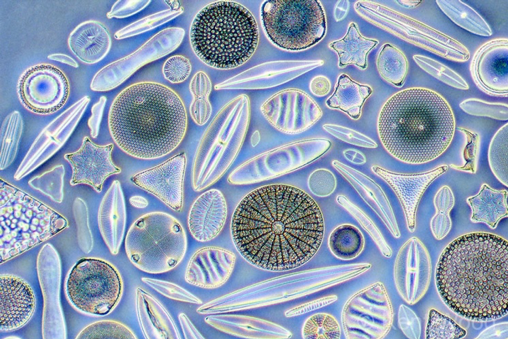
Bacillariophyceae (Photo Credit : Labroots)
- Chlorophyceae: or green algae, are essential components of aquatic ecosystems, playing a vital role in primary production, oxygen generation, nutrient cycling, and supporting biodiversity. Their diverse forms, from microscopic species to larger multicellular organisms, make them an important group in both freshwater and marine environments.
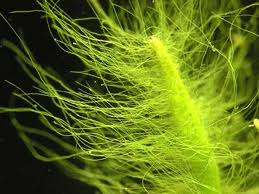
Chlorophyceae (Photo Credit : taxateca.com)
- Cyanophyceae: or blue-green algae, are unique, highly adaptable organisms with essential roles in aquatic ecosystems. They are key players in primary production, nitrogen fixation, and nutrient cycling, and they support a wide range of organisms in both freshwater and marine environments. While they contribute significantly to oxygen production and are critical for the health of aquatic food webs, their ability to form harmful algal blooms under certain conditions can pose environmental and health risks. Understanding the ecological roles and potential risks of cyanobacteria is crucial for managing water quality and protecting aquatic ecosystems
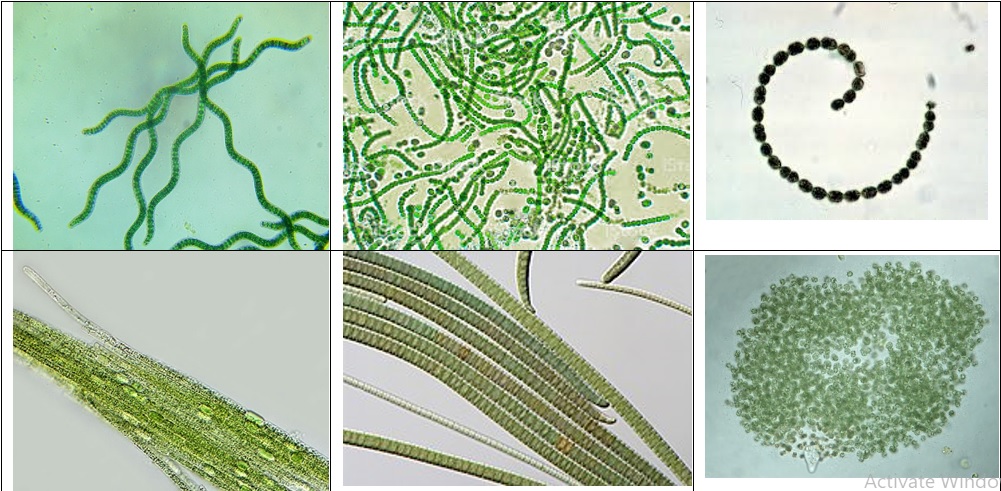
Cyanophyceae (Photo Credit : unair news)
- Dinophyceae: commonly known as dinoflagellates are a diverse and ecologically significant group of microorganisms in aquatic ecosystems. As primary producers, they contribute to the food web and play an important role in nutrient cycling. However, they are also responsible for harmful algal blooms, some of which produce toxins that can negatively affect marine life and human health. Understanding dinoflagellates’ behaviour, their role in ecosystems, and the environmental conditions that Favor their growth is crucial for managing the impacts of their blooms and protecting aquatic environments.
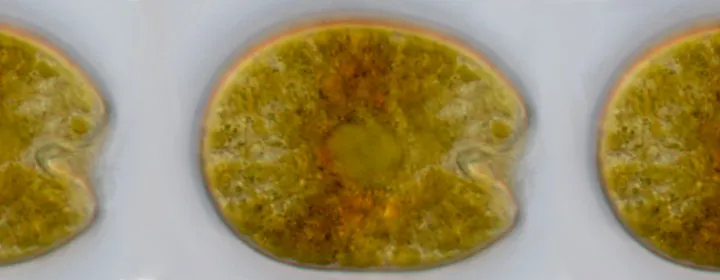
Dinophyceae (Photo Credit : lucidcentral)
The Role of Plankton in Aquatic Ecosystems
Though small in size, plankton are essential components of aquatic ecosystems. These microscopic organisms perform a variety of crucial functions that help sustain life in water bodies. One of their most significant contributions is oxygen production. Phytoplankton, the plant-like plankton, produce the majority of the oxygen in Earth's atmosphere through photosynthesis. This process not only helps maintain the balance of gases in the atmosphere but also supports life on our planet. In fact, around 50% of the oxygen we breathe comes from marine phytoplankton, making them one of the most important contributors to Earth’s breathable air.
Beyond oxygen production, plankton serve as the cornerstone of the aquatic food web. Phytoplankton, as primary producers, provide energy to zooplankton, the microscopic animals that feed on them. These zooplankton, in turn, become food for larger aquatic organisms, from small fish to marine mammals. This transfer of energy forms the foundation of the aquatic food chain. Without plankton, the energy required to sustain larger organisms would be unavailable, leading to a collapse in the entire food web.
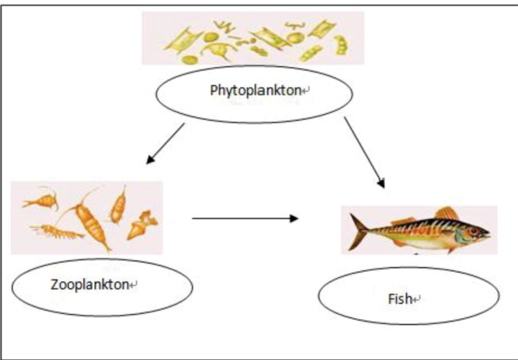
The food chain of the phytoplankton, zooplankton and fish (Photo Credit : Xia, et al.)
Moreover, plankton play a key role in nutrient cycling within aquatic environments. As phytoplankton photosynthesize, they absorb essential nutrients, such as nitrogen and phosphorus, from the water. These nutrients are passed along the food chain to other organisms. The continuous recycling of nutrients helps maintain the health and stability of aquatic ecosystems by ensuring that resources are available for other species to thrive.
Plankton also contribute to ecosystem balance. They regulate oxygen levels in the water, help sustain biodiversity, and support the overall structure of aquatic environments. However, disruptions to plankton populations—whether from pollution, climate change, or other environmental stressors—can have cascading effects throughout the ecosystem. Changes in plankton diversity and abundance can affect everything from water quality to fish populations, impacting the entire aquatic ecosystem.
In essence, plankton are not just small, floating organisms; they are the unsung heroes of the aquatic world. Protecting plankton populations and their environments is essential for maintaining the health of the planet’s ecosystems.
Plankton as Bioindicators of Aquatic Environments
In addition to supporting the food chain and maintaining ecosystem balance, plankton are also highly sensitive to environmental changes, making them valuable bioindicators of aquatic health. Plankton respond quickly to shifts in their environment, providing scientists with an early warning system for potential issues in water quality. Factors such as temperature, salinity, pH levels, and pollution can all influence plankton populations and diversity.
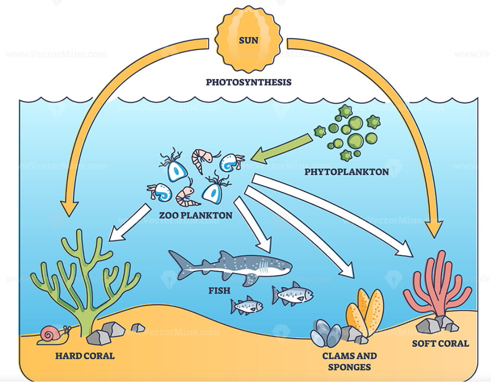
Plankton life and water organisms food chain role explanation outline diagram
Phytoplankton are sensitive to changes in environmental conditions. For instance, a sudden rise in water temperature or a shift in salinity can impact their growth and reproductive rates. Similarly, increases in pollution—such as the introduction of excess nutrients or toxic substances—can disrupt plankton communities, leading to changes in species composition. By closely monitoring plankton populations, scientists can detect these environmental shifts early, providing valuable insights into the health of aquatic ecosystems.
Changes in plankton composition can also serve as clear indicators of larger environmental shifts. For example, an overgrowth of certain types of phytoplankton may signal nutrient pollution, while shifts in zooplankton populations may reflect disruptions in the food web due to deteriorating water quality. These early changes often precede more visible shifts in the broader ecosystem, making plankton an invaluable tool for tracking and managing environmental changes.
Plankton thus serve not only as the foundation of aquatic food webs but also as sentinels of ecosystem health. By studying these tiny organisms, we can better understand the ongoing changes in our water bodies and take steps to mitigate environmental stressors before they escalate.
Factors Influencing Plankton Populations
The abundance and diversity of plankton in aquatic environments are influenced by a variety of factors. These factors can vary across different ecosystems and understanding them is key to comprehending how plankton thrive or struggle under changing condition. Below are the primary factors that affect plankton populations:
- Water Quality
The quality of water, defined by parameters such as pH, temperature, and salinity, plays a critical role in the survival of plankton. For instance, sudden changes in water temperature can disrupt the delicate balance needed for plankton to thrive. Polluted water, with altered pH or high salinity levels due to industrial discharges or agricultural runoff, can severely affect plankton diversity, making ecosystems more vulnerable to further environmental changes.
- Availability of Light
Phytoplankton, which rely on photosynthesis to produce energy, depend heavily on light availability. Shallow, clear waters typically allow more sunlight to penetrate, fostering healthy phytoplankton populations. However, in deeper or murkier waters, where light is limited, phytoplankton populations may be smaller or more seasonal. Pollution, including algae blooms or floating debris, can block sunlight and reduce phytoplankton growth. Changes in light availability, whether due to seasonal changes or human impact, can significantly affect plankton populations.
- Nutrient Availability
Plankton, especially phytoplankton, require nutrients like nitrogen and phosphorus for growth. In healthy ecosystems, these nutrients are available due to natural processes such as the breakdown of organic matter. However, excessive nutrient input, often due to human activities like agricultural runoff and wastewater discharge, can lead to eutrophication. While small amounts of nutrients can support plankton populations, excess nutrients can lead to harmful algal blooms. These blooms occur when phytoplankton grow rapidly in nutrient-rich waters, often fuelled by an abundance of nitrogen and phosphorus. Although algal blooms can initially increase plankton populations, they can also have severe negative effects, such as depleting oxygen levels in the water and producing toxins that harm aquatic life and even humans.
These blooms are most common in areas with high nutrient pollution, such as coastal zones or waters near industrial and agricultural areas. In some cases, these blooms can create "dead zones," areas where oxygen levels become so low that most marine life cannot survive. This highlights the critical need for managing nutrient levels and preventing over-enrichment of water bodies.
- Pollution and Climate Change
Pollution from industrial, agricultural, and urban runoff can drastically affect plankton communities. Pollutants like heavy metals, pesticides, and excess nutrients alter the chemical makeup of water, harming plankton, particularly sensitive species. Climate change further affects aquatic environments, shifting temperature and salinity patterns. Rising global temperatures can warm waters, favoring species that tolerate heat while displacing those that cannot. Additionally, changes in rainfall patterns, ocean acidification, and altered seasonal cycles further stress plankton populations. Climate change, combined with nutrient overload, increases the likelihood of harmful algal blooms and disrupts plankton populations on a larger scale.
Plankton Blooms: A Sign of Change
While plankton are essential for sustaining life in aquatic ecosystems, changes in their populations can also indicate significant shifts in the environment. One of the most notable phenomena involving plankton is the occurrence of phytoplankton blooms, which can happen when certain environmental conditions cause a rapid increase in plankton numbers.

Top view of phytoplankton blooms in the north sea (Photo Credit : GizemG)
Phytoplankton blooms occur when there is an excess of nutrients, particularly nitrogen and phosphorus, in the water. This excess can result from natural events, such as upwelling (where deep, nutrient-rich water rises to the surface), or from human-induced pollution, such as agricultural runoff or wastewater discharge. These blooms can significantly impact the water's ecosystem, oxygen levels, and even aquatic life itself.
In the right conditions, these blooms can be large and sustained, creating what’s known as harmful algal blooms (HABs). Some types of HABs release toxins that can poison marine life, contaminate drinking water, and pose health risks to humans who consume contaminated seafood. These blooms can also block sunlight from reaching deeper water layers, further affecting underwater life by disrupting photosynthesis in other aquatic plants.
The frequency and intensity of these blooms have increased with rising global temperatures and higher nutrient levels due to human activities. Climate change exacerbates these conditions by creating warmer waters, which favor the growth of certain phytoplankton species that thrive under these conditions. As a result, plankton populations can shift, leading to an imbalance in aquatic food webs and reduced biodiversity.
Although plankton blooms may seem like a natural process, the disruption they cause to the ecosystem highlights the fragile nature of aquatic environments. Monitoring plankton populations and detecting blooms early can provide vital information about the health of aquatic ecosystems and help mitigate the negative effects of over-enrichment and pollution.
Conclusion
Plankton play an indispensable role in the functioning of aquatic ecosystems. They are essential as primary producers, they support the food web, and they help regulate environmental conditions. While they are crucial for maintaining ecosystem balance, plankton populations can also act as early indicators of changes in water quality and ecosystem health. The occurrence of harmful algal blooms, driven by excessive nutrients and climate change, emphasizes the need for careful management of our water resources.
Protecting plankton and ensuring the health of aquatic ecosystems are key to safeguarding biodiversity and sustaining the balance of life in our oceans, lakes, and rivers. By studying plankton and understanding the factors that influence their populations, we can take proactive steps to preserve our water environments for future generations.
-Rika Novida

